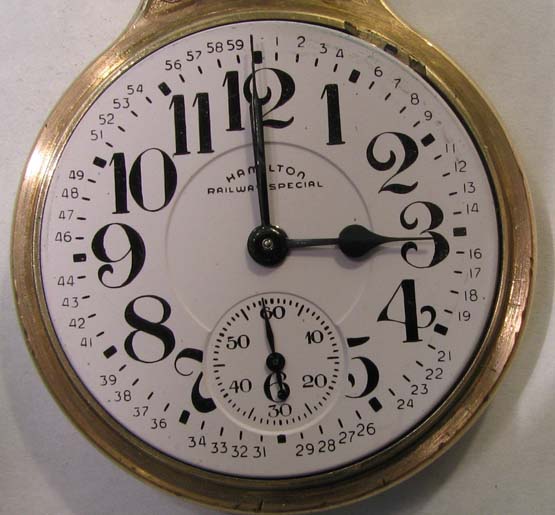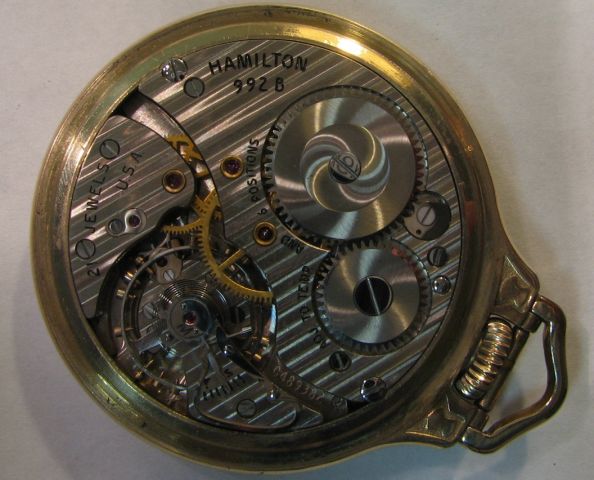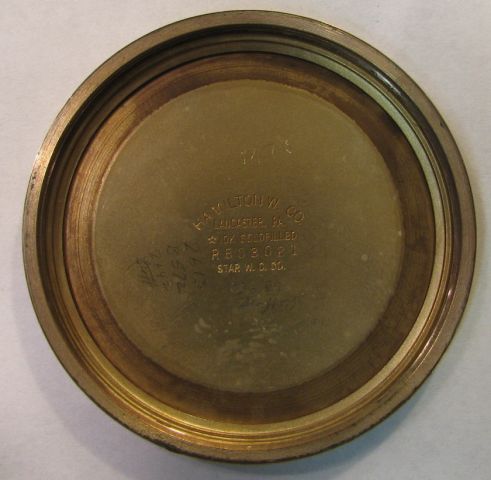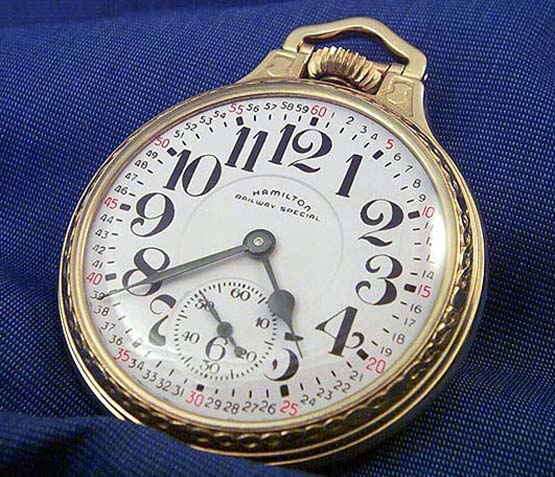
| WWT Shows | CLICK TO: Join and Support Internet Horology Club 185™ | IHC185™ Forums |

|
• Check Out Our... • • TWO Book Offer! • |
Welcome Aboard IHC185™  Internet Horology Club 185
Internet Horology Club 185  IHC185™ Discussion Site Main Page
IHC185™ Discussion Site Main Page  Horological Discussions, Questions and Answers
Horological Discussions, Questions and Answers  Pocket Watch Discussions
Pocket Watch Discussions  Hamilton 992B with Railway Special Dial
Hamilton 992B with Railway Special Dial
 Internet Horology Club 185
Internet Horology Club 185  IHC185™ Discussion Site Main Page
IHC185™ Discussion Site Main Page  Horological Discussions, Questions and Answers
Horological Discussions, Questions and Answers  Pocket Watch Discussions
Pocket Watch Discussions  Hamilton 992B with Railway Special Dial
Hamilton 992B with Railway Special DialGo  | New Topic  | Find-Or-Search  | Notify  | Tools  | Reply to Post  |  |
| IHC Life Member Site Moderator |
I recently acquired the 992B Hamilton pictured below. It has a mint, melamine Montgomery dial, however it seems to be missing the digits at 5, 10, 15, etc. Has anyone seen a dial like this before? It could be completely normal, I just don't have anything to compare it to. Also, the serial number of this 992B is C489382 which dates to the late 1950s. The Hamilton-signed Model #17 Star W. C. Co case has the serial number R803021. I don't see any other case screw marks. The case is in wonderful condition. Is it possible to tell if this is the original case to the watch? Thanks, John III  | ||
|
| IHC Life Member Site Moderator |
Movement  | |||
|
| IHC Life Member Site Moderator |
Case Markings  | |||
|
| IHC Life Member Site Moderator |
Front of watch with Bezel on  | |||
|
I've seen Montgomery dials with the red-numbers extremely faded. Are you certain that is not what happened? | ||||
|
| IHC Life Member Site Moderator |
Peter, That was one of the two conclusions I had initially, that the red letters faded. However,under a strong light and magnification, I cannot see any traces of red letting. Also, the rest of the dial is so bright, that it doesn't match a fading scenario. The other conclusion I had was that this is a normal, but rare variant, and I just haven't come across it yet. Thanks for the input, John | |||
|
| IHC President Life Member |
Hello John, Like Peter my impression and belief is that of a faded dial, remember that red fades quickly when exposed to sunlight whereas of course black does not. Often a faded melamine dial will have a somewhat grayish appearance and this one seems to be typical of that unfortunate condition. It would be hard to believe any dial would been printed, inspected installed and shipped without the red 5-minute numbers, however complete fading-out of red numbers is something we commonly find on these melamine dials. Today, an additional premium is being placed on top condition melamine dials as they are becoming increasingly difficult to find. About your case, the earliest Case 17 examples were by Keystone and marked as "Railroad #17" and "Hamilton Watch Co." in about the 1955-56 area. (Movement C421708 in Keystone Case K099890 is one such example.) Not long after introduction of the 17 Keystone went out of business. At that point identification was changed to Hamilton and Star markings such as you see on your case and those continued until the end. Apparently Star was using the "R" case number prefix such as yours in the 1950's and when those numbers ran out they went with a "P" prefix on their case numbers. Yes, "R" came before "P" with them. According to our "Projected Hamilton 992B Serial Numbers" your movement number C489382 dates to about 1964 production by which time the "P" prefix would be anticipated. But we also find that Hamilton apparently paid little or no attention to rotation of case inventory and last-in, first-out seems to have been the norm with them much of the time. For that reason it is certainly possible that an earlier case such as yours from the 1950s may have been found and used as they reached the "bottom of the bin" in the early 1960s just before a new order arrived from the case-maker. The style of your Case 17 is typical of 992B examples in the late 1950s then throughout the 1960s and even those from 1970 post-production. Hamilton melamine with bright red 5-minute markers...  | |||
|
Gentlemen, I was just wanting to know what is melamine? I am so new I have never came across an explanation yet. Thanks, John | ||||
|
Melamine is a hard plastic. When I was young it was used to make cheap dinner ware. I think it may still be available in that application but probably no longer called Melmac. | ||||
|
| IHC Vice President Pitfalls Moderator IHC Life Member |
As well as low-cost dinnerware, melamine is also widely used to make low-cost surfacing material for kitchen cabinets and countertops. Any material called "plastic laminate" in these applications will most likely be melamine. Getting back to melamine watch dials, there is a wealth of material already posted on this website. A key word search on "melamine dials" across the whole site gives 120 hits: Click here to view search results for "melamine dials" Best Regards, Ed | |||
|
| IHC Life Member Site Moderator |
Lindell, I really have to disagree with you about the dial even though I respect your opinion as a well known dial expert. In examining this dial and comparing it to other RR Special dials that I have, it is the brightest and closest to mint that I have seen. It is paper white compared to the other Hamilton four melamine dials that I have. My pictures don't do it justice. My issue with fading scenario is that there is absolutely no trace of any of the red numbers. If it was a fading issue, I would expect to see some traces of at least one of the numbers. It certainly appears to me that there never were any red numbers applied to this dial. Also, we shouldn't be so quick to assume that Quality Control at Hamilton was perfect in the sixties. I could think of several scenarios in which a less than perfect dial could have ended up on a watch. I can buy six 2 L bottles of Listerine in my company store for $1 because they have slight imperfections on the labels. Perhaps Hamilton didn't just throw away materials that were not perfect, but sold them at a discount. These are just my thoughts. I would like to send the watch to you to have you inspect it and tell me if it looks like other faded dials you have seen. I will also send the 18s hands that I promised a month ago. Thanks a bunch for the details on the Model 17 case. It seems like there is a possibility that this case/dial/movement combination is original. John III | |||
|
I have to agree that I have not seen a Melamine Montgomery with completely faded red-lettering. I too would expect to find some remnant of the lettering, however faint. But... Melamine is funny stuff. I would not guarantee that some chemical, used in cleaning, didn't kill those red letters. Still.... I'm hard pressed to believe that they would be totally obliterated. Here's a scenario that might work. I don't know if Hamilton made their own Melamine dials or outsourced them. But.... suppose that some dials were made without red-numbers, as defects. Although it was probably Hamilton's policy (or it's subcontractor's) to destroy those dials, you can never be 100% sure of everyone's honesty. Someone might have simply grabbed a handful of discarded defects and kept or sold them OR they might have been found after Hamilton (or the subcontractor) stopped producing them. You're right John.... even the US Mint lets defects slip through, from time to time... .and often it is traced to a dishonest employee. On the uses of Melamine... one of the largest uses, these days, is for those "black-boards" that use the erasable markers. That stuff if Melamine AND there is a specific cleaner for them. I'd think an experiment with that cleaner is very tempting (unless it's just a solution of soapy water | ||||
|
I worked in the printing industry for 30+ yrs and there is not enough quality control in the world to assure "no defects" leave the building. The red and black I am sure were applied as separate steps, and each dial could have looked just like John's example at a point in the process. The first few sheets in a printing press are discarded until the color comes up, and this was probably the case with dials. Although my first reaction was fading of the red numberals, I can see where Johns assumptions could be more likely. My guess is it came out of the discard pile. Charlie | ||||
|
| IHC Vice President Pitfalls Moderator IHC Life Member |
The numbers were just printed on these melamine dials. They were not fired. So if a chemical solvent-cleaner was used on this dial, it is entirely possible that the red numbers could have been dissolved without a trace and not the black ones, due to some difference in the ink composition. On the other hand, Charlie's "discard pile" theory can't be dismissed out of hand either. The only way I can think of to be absolutely certain that was the case would be if the dial was still in a sealed NOS cellophane wrapper, which is not the case here. So I guess what we have here is an "argumentative example" to borrow Mike Chamelin's phrase. However, until other examples like John's dial can be found, I have to lean toward something (like sunlight and/or chemical cleaners) having made the red numbers go away as the more likely explanation. Bottom line: This is most likely an ordinary dial that has simply been degraded over the years rather than some rare manufacturing error. The late Bill Meggers once quoted Roy Ehrhardt to me: Roy always says "It's better to own one of two known than to own the only one known." Best Regards, Ed | |||
|
| IHC Life Member Site Moderator |
Gentlemen, I really appreciate the input. While I would like to hope I have something special, some of the points made above by well-respected folks make me less optimistic. Either way, it is an interesting discussion. Thanks, John iII | |||
|
I have problems with the discarded pile theory. I have talked to many Hamilton employees from those days. If they were caught doing such a thing, they would have been fired on the spot, and they were watched carefully. One friend was almost fired when he was told to dispose of some material and another supervisor saw him near the disposal area and reported him. They called him to the head office and were about to can him when the first supervisor came to veryify the story. I know of a few hairsprings that made it out of the factory near the very end, but it was very dangerous and employees knew the risk was not worth the reward. I vote for the bleached numbers. Don | ||||
|
| IHC Member 638 |
Hi John, I have 992B: C494194 in a Star model #17 P370367 My brother Tom has 992B: C492609 in a Star model #17 P884924 This may further validate what Lindell stated: "that Hamilton apparently paid little or no attention to rotation of case inventory" Mike | |||
|
| Powered by Social Strata |
| Your request is being processed... |
|
Welcome Aboard IHC185™  Internet Horology Club 185
Internet Horology Club 185  IHC185™ Discussion Site Main Page
IHC185™ Discussion Site Main Page  Horological Discussions, Questions and Answers
Horological Discussions, Questions and Answers  Pocket Watch Discussions
Pocket Watch Discussions  Hamilton 992B with Railway Special Dial
Hamilton 992B with Railway Special Dial
 Internet Horology Club 185
Internet Horology Club 185  IHC185™ Discussion Site Main Page
IHC185™ Discussion Site Main Page  Horological Discussions, Questions and Answers
Horological Discussions, Questions and Answers  Pocket Watch Discussions
Pocket Watch Discussions  Hamilton 992B with Railway Special Dial
Hamilton 992B with Railway Special Dial©2002-2025 Internet Horology Club 185™ - Lindell V. Riddle President - All Rights Reserved Worldwide

